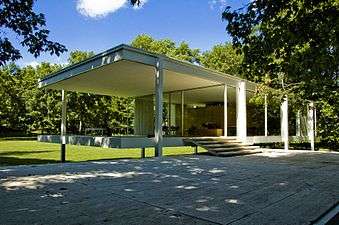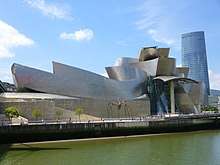Architectural icon
Architectural icon is a term from Architecture criticism and designates buildings that are or were groundbreaking or claim uniqueness because of their design.
Definition
These outstanding buildings and ensembles meet several of the following criteria:
- widespread recognition
- popularity
- originality
- symbol value
- significance for the development of architecture
- representative of an architectural style
Sabine Thiel-Siling writes in her preface to Architectural icons of the 20th century: "The buildings are spectacular for their time and their surroundings, whether through their constructive achievements or innovative use of materials, through their formal language or because they embodied a completely new type of building for the first time."[1]
Some buildings have developed into pilgrimage venues for architecture enthusiasts or have even become landmarks of cities, even countries. But they have often been misunderstood by laymen, even when they have become role models for entire generations of architects.
Tom Wright, the architect of Burj al Arab said on the same subject: "How can you tell that a building has become a symbol? If you can draw it in five seconds, and everyone knows what it is."[2]
Criticism
In order to achieve an abstract goal, architects often plan outside the needs of their clients. The Chicago physician Edith Farnsworth, who commissioned Ludwig Mies van der Rohe in 1945 to design a weekend house in which she could retreat for relaxation, was not impressed by the purism of her Farnsworth House, which cost her a lot of money, and expressed herself to the architect as follows: "I wanted something "meaningful," and all I got was this smooth, superficial sophistry" (in German: Ich wollte etwas „Bedeutungsvolles“ haben, und alles was ich bekam, war diese glatte, oberflächliche Sophisterei.)[3]
And it was precisely this mansion that became a place of pilgrimage for architectural tourists. People LeBlanc writes about: "The architectural tourist is a courageous man who easily plans a whole journey to see a certain building; who looks for half a day to find it; who lingers for hours at the threshold, hoping to enter. But his tenacity is worth it, because to fully understand a building, you have to see it for yourself." (in German: "Der Architekturtourist ist ein beherzter Mensch, der ohne weiteres eine ganze Reise plant, um ein bestimmtes Bauwerk zu sehen; der einen halben Tag sucht, um es zu finden; der stundenlang an der Türschwelle herumlungert, in der Hoffnung, hineinzukommen. Doch seine Hartnäckigkeit lohnt sich, denn um ein Gebäude voll und ganz zu verstehen, muss man es selbst sehen".)[3]
Jürgen Tietz, who in the Neuen Zürcher Zeitung[4] critically examines the urge for ever new architectural symbols triggered by the so-called "Bilbao effect" of Frank O. Gehry's Guggenheim Museum in the Basque Bilbao, also takes up the fact that you have to see a building yourself. First this fashion wave reached the metropolises before it reached the smaller cities, because the more distinctive a building is, the better it can be marketed. Well-known buildings ensure that individual locations are immediately recognizable: The Eiffel Tower stands for Paris and the Parthenon for Athens.
In the times of globalization architectural icons are becoming trademarks in the competition between metropolises: "At the same time, the growing inflation on the catwalk of architectural images threatens to contribute to general confusion. Did this house stand in Hamburg, Tokyo or Paris? Was it the museum in Bern, Manchester or Seoul? Was it the architect Eisenman, Koolhaas or Piano?" (in German: Zugleich droht die wachsende Inflation auf dem Catwalk der Architekturbilder zur allgemeinen Verwirrung beizutragen. Stand dieses Haus in Hamburg, Tokio oder Paris? War es das Museum in Bern, Manchester oder Seoul? Hiess der Architekt Eisenman, Koolhaas oder Piano?) The dilemma of this architecture, which is oriented towards the visual effect, is that it must rely on the quick glance. Tietz calls it "an architectural fast food that is as easy to consume as possible" (in German: ein möglichst leicht konsumierbares architektonisches Fast Food).[4] At the same time, it is often forgotten that what constitutes the quality of architecture can only be experienced on location: "But the Modernist building set is also constantly generating new images for worldwide marketing in the architectural circus: ecologically ambitious at Foster, elegantly expressive at Gehry, zigzag deconstructed at Libeskind. (in German: Doch auch der Baukasten der Moderne generiert laufend neue Bilder für die weltweite Vermarktung im Architekturzirkus: ökologisch ambitioniert bei Foster, elegant expressiv bei Gehry, zackig dekonstruiert bei Libeskind.)[4]
However, these computer-designed, constructed marketing strategies threaten, according to Tietz, to turn architecture into a cliché that is full of Potemkin villages.[4]
Some examples
An example of this is the Seagram Building in New York, which became the icon of the modern skyscraper and in the following decades the most imitated example of its kind worldwide. The construction of the Sydney Opera House was part of a rethinking of 1950s architecture.
As icons of a place or a time, today one rather erects buildings like the opera house in Sydney or the Guggenheim Museum in Bilbao. However, they have a similar function as the colossal statues and shape the image of the respective city internationally.
— Andres Lepik, Skysraper[5]
List (selection)
This list can never be complete, but it should give an overview of the diversity of building.
| Picture | Name / Year | Architect | Place | Notes |
|---|---|---|---|---|
 |
Parthenon 5th century BC |
Athens, Greece | Classical Greek temple, famous since its construction for its harmonious proportions, considered by many to be the "summit of all architecture"[6] and a perfect expression of humanity. | |
 |
Pantheon 119/125 |
Rome, Italy | The Pantheon, completed under Emperor Hadrian, had the largest dome in the world for more than 1700 years, measured by its inner diameter, and is generally regarded as the best preserved building of Roman antiquity. | |
.jpg) |
Hagia Sophia 537 |
Istanbul, Turkey | Hagia Sophia, built as a domed basilica, set new architectural accents in the 6th century. The significance of the dome in terms of architectural history lies not in its size, but rather in the fact that for the first time it rests on only four pillars and hovers above the room below. | |
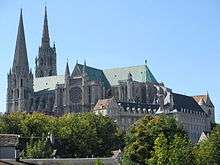 |
Chartres Cathedral 1260 |
Chartres, France | Chartres Cathedral is the meeting place of many art and cultural historical currents. At the beginning of the classical phase of Gothic architecture, there were two fundamentally different approaches, of which only one was successful and which has become much better known. | |
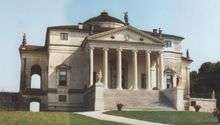 |
Villa Capra "La Rotonda" 1571 |
Andrea Palladio | Vicenza, Italy | Ideal Renaissance building whose aesthetics sought to match those of ancient models. Thomas Jefferson anonymously submitted a plan to the competition for the design of the presidential residence in Washington D.C., which was a variation of the Villa Rotonda. This design was not accepted, but he picked up elements for his own home in Monticello. |
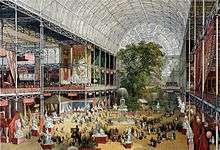 |
The Crystal Palace 1851 |
Joseph Paxton | London, United Kingdom | Prefabricated building based on serially manufactured modular components. To showcase the construction so consciously with representative architecture was a novelty. |
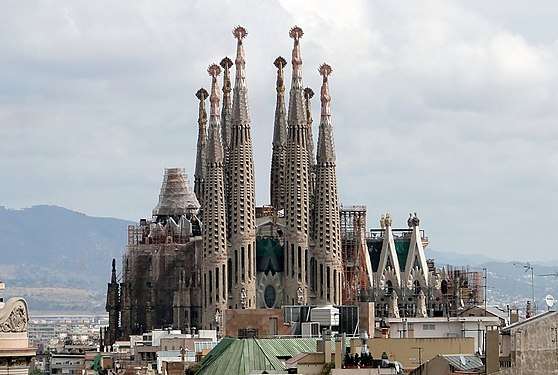 |
Sagrada Família 1882 |
Antoni Gaudí | Barcelona, Spain | The Sagrada Família is an unusual work of sacral architecture that reinterprets Gothic motifs with modern means. |
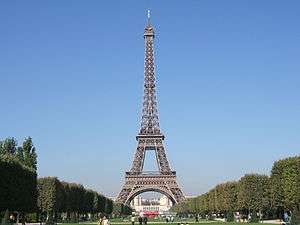 |
Eiffel Tower 1889 |
Gustave Eiffel | Paris, France | For 41 years since its erection, the wrought iron framework has been the world's tallest structure, triggering a worldwide wave of tower construction. The outstanding architectural position is based on the one hand on the many buildings that followed the construction principle, some of which even copied the appearance, and on the other hand the tower was built completely without any historical model. |
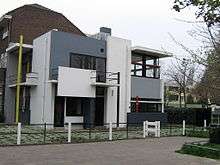 |
Rietveld Schröder House 1924 |
Gerrit Rietveld | Utrecht, Netherlands | The building is one of the most important buildings of the De Stijl movement. |
 |
Chilehaus 1924 |
Fritz Höger | Hamburg, Germany | The Chilehaus was exemplary for the brick expressionism of the 1920s. With its ship's bow-like tip, it became an icon of Expressionism in architecture. |
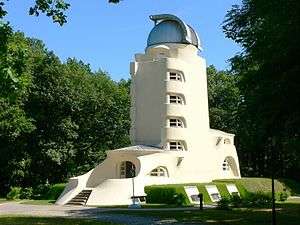 |
Einstein Tower 1924 |
Erich Mendelsohn | Potsdam, Germany | The observatory in the Albert Einstein Science Park on the Telegraphenberg in Potsdam is a revolutionary building for its time of origin. |
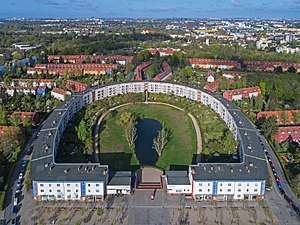 |
Hufeisensiedlung 1925–1930 |
Bruno Taut | Berlin, Germany | The Hufeisensiedlung, to which the holiday home "Tautes Heim" belongs, is internationally regarded as a key work of reform-oriented urban housing construction. |
| Bauhaus Dessau 1926 |
Walter Gropius | Dessau, Germany | Apart from the then novel functional separation by individual structures joined together to form an organism, the special feature is the wall of the workshop wing, which is completely dissolved in glass. | |
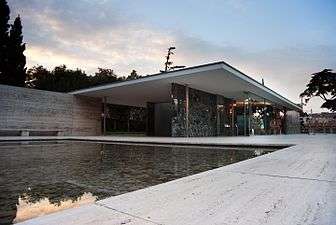 |
Barcelona Pavilion 1929 |
Ludwig Mies van der Rohe | Barcelona, Spain | The building, which became a style-setter for modern architecture, realized two design principles of van der Rohe: Free plan and "Floating roof". |
| Villa Tugendhat 1930 |
Ludwig Mies van der Rohe | Brno, Czech Republic | Construction and wall were strictly separated from each other and should allow a "freely" divisible floor plan. | |
 |
Fallingwater 1937 |
Frank Lloyd Wright | near Pittsburgh, Pennsylvania, United States | The client wanted a building with a view of the waterfall. After an accurate survey of the site, which included all trees and rocks, Wright suggested that the building be built over the waterfall. |
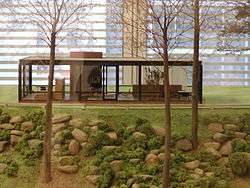 |
Glass House 1949 |
Philip Johnson | New Canaan, Connecticut, United States | The Glass House is characterised by a radical reduction of the exterior walls. |
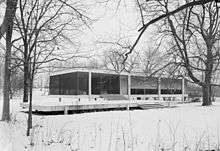 |
Farnsworth House 1951 |
Ludwig Mies van der Rohe | Plano Illinois, United States | The exterior walls are completely made of glass and allow a direct connection to nature in every situation, only light curtains are provided for privacy. |
| Notre Dame du Haut 1955 |
Le Corbusier | Ronchamp, France | Due to its organic shape, the church is also a place of pilgrimage for architects and art lovers. | |
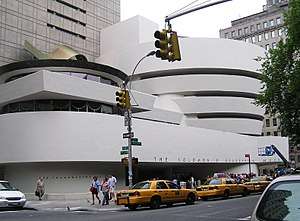 |
Solomon R. Guggenheim Museum 1959 |
Frank Lloyd Wright | New York City, New York, United States | Wright created a winding ramp and an elevator that transports visitors to the highest point of the ramp so they can walk down past the artworks. |
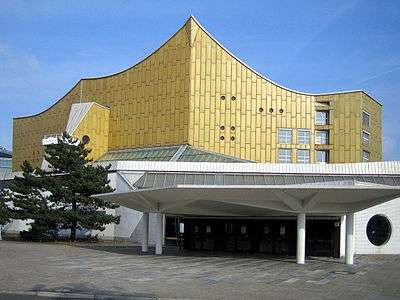 |
Berliner Philharmonie 1963 |
Hans Scharoun | Berlin, Germany | The architecture largely removes the separation between artist and audience, the artists sit "in the midst" of the audience. |
| Montreal Biosphere 1967 |
Richard Buckminster Fuller | Montreal, Canada | The US pavilion at Expo 67 in Montreal is made of steel and acrylic and was the model for numerous subsequent buildings. | |
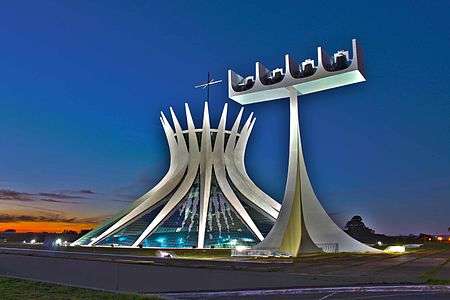 |
Cathedral of Brasília 1970 |
Oscar Niemeyer | Brasília, Brazil | The cathedral and parliament building characterise the newly built Brazilian capital. |
 |
Finlandia Hall 1971 |
Alvar Aalto | Helsinki, Finland | The architectural style is functionally oriented and offers a vivid contrast to the often melancholic landscape. |
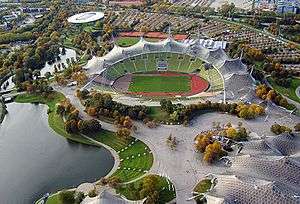 |
Olympiastadion Munich 1972 |
Günter Behnisch | Munich, Germany | The Olympiapark architectural group designed a stadium that is embedded in the landscape. The Olympic Stadium became the symbol of a new lightness of German post-war architecture. |
.jpg) |
Sydney Opera House 1973 |
Jørn Utzon | Sydney, Australia | The Sydney Opera House is a popular tourist attraction, landmark of Sydney and Australia. Denmark also sees the Opera House today as part of its cultural heritage. |
| Centre Georges Pompidou 1977 |
Renzo Piano, Richard Rogers and Gianfranco Franchini | Paris, France | The supporting structure and pipes for building services engineering and development were visibly arranged on the outside of the building. Significant step towards modern architecture and postmodern architecture. | |
 |
Louvre Pyramid 1989 |
Ieoh Ming Pei | Paris, France | The pyramid consists of 602 rhombic and 69 triangular glass segments. The Great Pyramid of Giza served as a model for the proportions. |
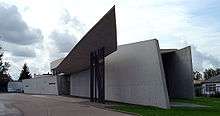 |
Fire station 1993 |
Zaha Hadid | Weil am Rhein, Germany | The structure consists of clearly cut serrations and edges in a pane construction. |
 |
Oriental Pearl Tower 1995 |
Jia Huancheng | Shanghai, China | Its unique construction of eleven spheres of different sizes at different heights, supported by columns, has become one of the most famous landmarks of the city of Shanghai. |
 |
Therme Vals 1996 |
Peter Zumthor | Vals, Switzerland | The spa is reminiscent of a quarry from which cuboids were cut out. The remaining blocks and the cavities between them form the entire building. |
 |
Niterói Contemporary Art Museum 1996 |
Oscar Niemeyer | Niterói, Brazil | The Niterói Contemporary Art Museum has a diameter of 50 m and reminds with its form of the foot of an atomic mushroom or of a UFO. |
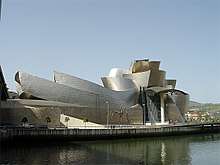 |
Guggenheim Museum Bilbao 1997 |
Frank Gehry | Bilbao, Spain | The very bizarre building is famous for its deconstructivist architectural style. But the museum building also stands for economic success, see Bilbao Effect. |
.jpg) |
Burj al Arab 1999 |
Tom Wright | Dubai, United Arab Emirates | The client wanted a landmark for Dubai, which the architect implemented with the help of a memorable form. Within very short time, the luxury hotel in the form of a yacht sail became Dubai's identification mark. |
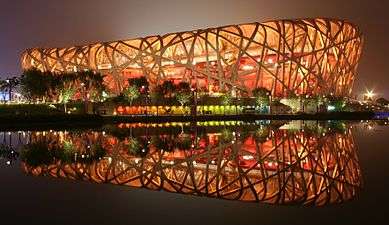 |
Beijing National Stadium 2008 |
Herzog & de Meuron | Beijing, China | Due to its shape, the stadium has the nickname "bird's nest". The architect Jacques Herzog hopes that "this building will become for Beijing what the Eiffel Tower is for Paris". |
| Burj Khalifa 2010 |
Adrian Smith | Dubai, United Arab Emirates | Since 2008, the Burj Khalifa is the tallest building in the world. The investors kept the height secret until the opening on 4 January 2010. With the Burj Khalifa, the various categories of records of the tallest building will be awarded to a single building for the first time since the Empire State Building was erected in 1931. | |
| Metropol Parasol 2011 |
Jürgen Mayer | Sevilla, Spain | The new landmark of Seville has a length of 150 meters, a width of 70 meters and a height of 26 meters and is considered the largest wooden construction in the world. |
See also
References
- Sabine Thiel-Siling, ed. (1998). Architektur! Das 20. Jahrhundert [Architecture! The 20th Century]. Munich: Prestel Publisher. ISBN 978-3791320137.
- Lee, Jonathan (2006-07-01). 50 große Abenteuer. Besondere Orte und die Menschen, die sie geschaffen haben [50 huge adventures. Special places and the people who created them]. Munich: Prestel Publisher. ISBN 978-3791335308.
- LeBlance, Sydney (1998). Moderne Architektur in Amerika [Modern Architecture in America]. Munich: Deutsche Verlagsanstalt. ISBN 978-3421031365.
- Tietz, Jürgen (2006-01-30). "Gebaute Zeichen" [Built symbols]. www.nzz.ch. Retrieved 2019-06-18.
- Andres Lepik: Skyscraper. Prestel Publisher, 2004, Munich, ISBN 978-3791331553. Quote: "Als Ikonen eines Ortes oder einer Zeit errichtet man heute eher Bauwerke wie das Opernhaus in Sydney oder das Guggenheim-Museum in Bilbao. Sie haben jedoch eine ähnliche Funktion wie einst die Kolossalstatuen und prägen international das Bild der jeweiligen Stadt."
- Pevsner, Nikolaus (2008-04-28). Europäische Architektur von den Anfängen bis zur Gegenwart [European architecture from its beginnings to the presence]. Munich: Prestel. p. 11. ISBN 978-3791339276.
Further reading
- Jencks, Charles (2005-04-24). The Iconic Building: The Power of Enigm. London: Frances Lincoln Publishers. ISBN 978-0711224261.
- Kuhl, Isabel (2007-07-12). 50 Bauwerke, die man kennen sollte [50 buildings you should know about]. Munich: Prestel Publisher. ISBN 978-3791338378.
- Lee, Jonathan (2006-07-01). 50 große Abenteuer. Besondere Orte und die Menschen, die sie geschaffen haben [50 huge adventures. Special places and the people who created them]. Munich: Prestel Publisher. ISBN 978-3791335308.
- Lepik, Andres (2004-08-25). Skyscrapers. Munich: Prestel Publisher. ISBN 978-3791331553.
- Parkyn, Neil (March 2006). Siebzig Wunderwerke der Architektur [Seventy marvels of architecture]. Munich: Frederking & Thaler. ISBN 978-3894055363.
- Sabine Thiel-Siling, ed. (1998). Architektur! Das 20. Jahrhundert [Architecture! The 20th Century]. Munich: Prestel Publisher. ISBN 978-3791320137.
External links
- Comstock, Paul (2007-04-03). "The iconic building. An Interview With Architect Charles Jencks". archive.org. Retrieved 2019-06-19.
